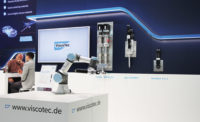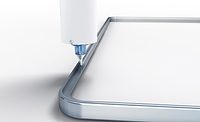Adhesives for Electronics Assembly
Adhesives provide a strong bond during electronics assembly while protecting components against potential damage.

Recent innovations in the electronics industry, such as hybrid vehicles, mobile electronic devices, medical applications, digital cameras, computers, defense telecommunications, and augmented reality headsets, touch nearly every part of our lives. Electronics adhesives are a crucial part of assembling these components, with a range of different adhesive technologies available to address specific application needs.
Adhesives provide a strong bond while protecting components against the damaging effects of excessive vibration, heat, moisture, corrosion, mechanical shock, and extreme environmental conditions. They also offer thermal and electrically conductive properties, as well as UV curing abilities.
As a result, electronics adhesives have successfully replaced many traditional soldering systems. Typical applications where these adhesives can be used in electronics assembly include masking before conformal coating, heat sinks, electric motor applications, potting fiber optic cable connections, and encapsulation.
Masking before Conformal Coating
Conformal coating is a polymeric film technology applied to a sensitive printed circuit board (PCB) to protect its components against vibration, corrosion, moisture, dust, chemicals, and environmental stresses, as these external factors can decrease the performance of the electronic components. Every type of coating (e.g., acrylic, polyurethane, water-based, and UV-cure) acts according to its specific properties in the different environments in which the PCB operates. Therefore, it is important to select the best coating material for the required protection.
Masking is a process applied before conformal coating that protects specified regions of PCBs from being coated, including sensitive components, LED surfaces, connectors, pins, and test sites where electrical continuity must be maintained. These must remain uncoated in order to carry out their functions. Peelable masks provide excellent protection of the restricted areas by preventing invasion of conformal coatings into these areas.
The masking process comprises four steps: application, curing, inspection, and removal. After applying a UV-curable masking product on the required components, it cures completely in seconds following exposure to UV visible light. The fast cure allows circuit boards to be processed immediately. After dipping, spraying, or hand application of the conformal coating, the mask is peeled off, leaving a residue- and contaminant-free surface. Masking can successfully replace traditional time-consuming methods.
The masking application method is extremely important. If the product is applied poorly, even if it is the best-fit choice, it will not provide adequate protection. Before the application, it is necessary to clean the surfaces to avoid outside contaminants and preplan which areas of the board require masking. Sensitive areas that do not need coating must be masked. Masking products are available in high-visibility colors such as pink, blue, amber, and green.
Manual or automated dispensing is ideal for the masking application. If hand coating, the mask should not be applied too thickly. Likewise, over-applying is a potential risk when brush coating. When the application ends, regardless of the application method, the masking should be removed once the board is dried.

Magnet bonding adhesives for electric motors.
Heat Sink Attachment
As electronic devices become smaller, the power and correlated heat they consume becomes more concentrated and must be dissipated, making heat transfer more valuable. A heat sink is a heat dissipation device that consists of a base and fins. When a chip heats up, the heat sink disperses the heat to keep the chip at a proper temperature. Without a heat sink, chips would overheat and destroy the entire system.
Heat sink adhesives have been designed for bonding heat sinks to electrical components and circuit boards to dissipate heat. This process requires high thermal conductivity and strong structural bonds, and these adhesives rapidly and effectively transfer heat away from power components to the heat sink. Heat sink bonding applications are common in computers, electric vehicles, refrigerators, LED lights, mobile phones, and memory devices.
Heat sink adhesives can be easily applied with syringes or dispensing machines. Before the application, the component’s surface must be cleaned thoroughly and properly with a clean cloth and an appropriate solvent. During application, the adhesive should fill the component surface entirely, leaving no air gap, which leads to a heat dissipation within the enclosure. This process protects electronic circuits from overheating, maximizes efficiency, minimizes cost, and improves product reliability.
Magnet Bonding in Electric Motors
Electric motors play a key role in our daily life, finding use in electric vehicles (e.g., automobiles, buses, trains, watercrafts, aircrafts, and subway systems), dishwashers, electric toothbrushes, computer printers, vacuum cleaners, and more. Due to the strong trend toward electric vehicles in the transportation industry, most of the modern discussion in that sector involves the concept of replacing the main gas-powered engine with an electric version.
Even in vehicles with combustion engines, dozens of electric motors are at work, enabling everything from windshield wipers to electric locks and heater fans. Adhesives and sealants find many uses throughout electric motors in these components, primarily in magnet bonding, retaining bearings, creating gaskets, and threadlocking engine mounting bolts.
Magnets are bonded in place with adhesives for several reasons. First, the structure of a magnet is brittle and subject to cracking under pressure. Using clips or metal fasteners is discouraged because these methods focus stress into points on the magnet. In contrast, adhesives disperse bonding stresses much more evenly across the surface of a bond. Second, any space between metal fasteners and the magnet allows for vibration, resulting in increased noise and wear on parts. Adhesives are therefore preferred to minimize noise.
Potting and Encapsulation
Potting is the process of filling an electronic component with a liquid resin such as epoxy, silicone, or polyurethane. This process protects sensitive electronic devices like printed sensors, power supplies, connectors, switches, circuit boards, junction boxes, and power electronics against potential environmental threats, including: chemical attacks; pressure differentials that may occur in spacecraft or aircraft; thermal and physical shocks; or conditions like vibration, moisture, and humidity. These threats can all severely damage and destroy these types of sensitive electronics.
Once the resin is applied, dried, and cured, the covered components are secured. However, if air gets trapped in the potting compound, it produces air bubbles that result in performance issues in the finished component.
In encapsulation, the component and hardened resin are removed from the pot and placed in an assembly. As electronic devices continue shrinking, encapsulation becomes more necessary to make the internal elements durable and hold them in position.
While deciding what potting compound is ideal for an application, as well as which elements must be protected, it also is important to consider the components’ operating temperatures, production conditions, cure times, property changes, and mechanical stresses. There are three major types of potting compounds: epoxies, urethanes, and silicones. Epoxies offer excellent strength and versatility with superb chemical and temperature resistance, while urethanes are more flexible than epoxies with less resistance to chemicals and high temperatures. Silicones also are resistant to many chemicals, and they offer good flexibility. The main drawback to silicone resins, however, is cost. They are the most expensive option.

Sealing electronic boards with potting adhesives.
Potting Fiber Optic Cable Connections
When bonding fiber optic cable connections, it is important to choose an adhesive that improves the assembly’s performance and stability while decreasing cost. Though traditional methods like welding and soldering lead to unwanted heat, adhesives perform much better by protecting the internal components from extreme heat, moisture, and chemicals.
Epoxy adhesives and UV-cure systems are used in potting fiber optic cable connections. These products offer superior bond strength, excellent optical clarity, and high resistance to corrosion and harsh environmental conditions. Common applications include sealing fibers into ferrules, bonding fiber optic bundles into ferrules or connectors, and potting fiber optic bundles.
Expanding Applications
Adhesives have found ever-expanding use in electronics assembly in recent years. The type of adhesive, the method of application, and the amount of the adhesive applied are the most important factors to achieving reliable performance in electronics components. While adhesives play a key role in joining electronic assemblies, there remains work to do since adhesives are expected in the near future to offer higher mechanical and thermal properties that will increasingly replace traditional soldering systems.
For more information, visit www.hernon.com.
Note: Photos courtesy of Hernon Manufacturing, Inc.
Looking for a reprint of this article?
From high-res PDFs to custom plaques, order your copy today!






